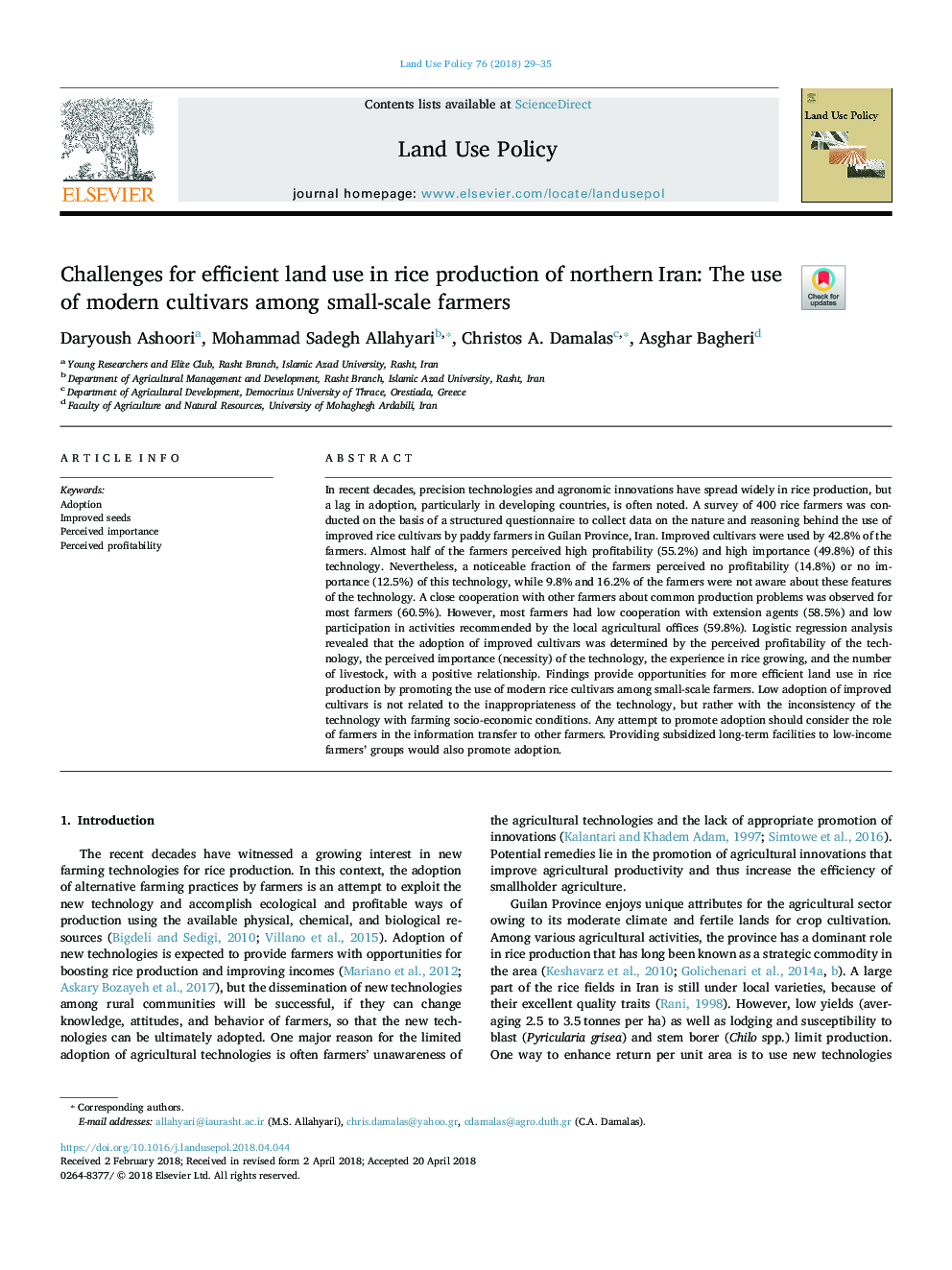| کد مقاله | کد نشریه | سال انتشار | مقاله انگلیسی | نسخه تمام متن |
|---|---|---|---|---|
| 6546233 | 1421807 | 2018 | 7 صفحه PDF | دانلود رایگان |
عنوان انگلیسی مقاله ISI
Challenges for efficient land use in rice production of northern Iran: The use of modern cultivars among small-scale farmers
ترجمه فارسی عنوان
چالش های کاربرد کارآی زمین در تولید برنج در شمال ایران: استفاده از ارقام مدرن در میان کشاورزان کوچک
دانلود مقاله + سفارش ترجمه
دانلود مقاله ISI انگلیسی
رایگان برای ایرانیان
کلمات کلیدی
تصویب، دانه های بهبود یافته، اهمیت درک، سودآوری درک شده،
ترجمه چکیده
در دهه های اخیر، فناوری های دقیق و نوآوری های زراعی به طور گسترده ای در تولید برنج گسترش یافته است، اما اغلب اشاره ای به تأخیر در پذیرش، به ویژه در کشورهای در حال توسعه است. یک نظرسنجی از 400 کشاورز برنج بر اساس پرسشنامه ساخت یافته برای جمع آوری داده ها در مورد ماهیت و استدلال پشت استفاده از ارقام بهبود یافته برنج توسط کشاورزان سرسبز استان گیلان انجام شد. ارقام بهبود یافته توسط 42.8٪ از کشاورزان مورد استفاده قرار گرفتند. تقریبا نیمی از کشاورزان، سودآوری بالا (55.2٪) و اهمیت بالا (49.8٪) از این فناوری را درک کردند. با این وجود، بخش قابل توجهی از کشاورزان هیچ سودآوری (14.8٪) یا اهمیت (12.5٪) از این فناوری را نمی دانستند، در حالی که 9.8٪ و 16.2٪ از کشاورزان در مورد این ویژگی های این فناوری آگاه نبودند. همکاری نزدیک با سایر کشاورزان در مورد مشکلات تولید مشترک در بیشتر کشاورزان (60.5٪) مشاهده شد. با این حال، بیشتر کشاورزان همکاری کمتری با عوامل توسعه (58.5٪) و مشارکت کم در فعالیت های توصیه شده توسط ادارات محلی کشاورزی (59.8٪) داشتند. تجزیه و تحلیل رگرسیون لجستیک نشان داد که تصویب ارقام بهبود یافته با در نظر گرفتن سودآوری تکنولوژی، اهمیت (ضرورت) درک فناوری، تجربه برنج در حال رشد و تعداد دام های با رابطه مثبت تعیین شده است. یافته ها با استفاده از ارقام برنج مدرن در میان کشاورزان کوچک، امکان استفاده بهتر از زمین را در تولید برنج ایجاد می کنند. پذیرش کمتری از ارقام بهبود یافته به عدم انطباق تکنولوژی مربوط نمی شود، بلکه با ناسازگاری تکنولوژی با شرایط اقتصادی اجتماعی اقتصادی همراه است. هر گونه تلاش برای ترویج پذیرش باید نقش کشاورزان در انتقال اطلاعات به دیگر کشاورزان را در نظر بگیرد. فراهم کردن امکانات درازمدت یارانه ای برای گروه های کشاورزان کم درآمد نیز باعث تقویت پذیرش خواهد شد.
موضوعات مرتبط
علوم زیستی و بیوفناوری
علوم کشاورزی و بیولوژیک
جنگلداری
چکیده انگلیسی
In recent decades, precision technologies and agronomic innovations have spread widely in rice production, but a lag in adoption, particularly in developing countries, is often noted. A survey of 400 rice farmers was conducted on the basis of a structured questionnaire to collect data on the nature and reasoning behind the use of improved rice cultivars by paddy farmers in Guilan Province, Iran. Improved cultivars were used by 42.8% of the farmers. Almost half of the farmers perceived high profitability (55.2%) and high importance (49.8%) of this technology. Nevertheless, a noticeable fraction of the farmers perceived no profitability (14.8%) or no importance (12.5%) of this technology, while 9.8% and 16.2% of the farmers were not aware about these features of the technology. A close cooperation with other farmers about common production problems was observed for most farmers (60.5%). However, most farmers had low cooperation with extension agents (58.5%) and low participation in activities recommended by the local agricultural offices (59.8%). Logistic regression analysis revealed that the adoption of improved cultivars was determined by the perceived profitability of the technology, the perceived importance (necessity) of the technology, the experience in rice growing, and the number of livestock, with a positive relationship. Findings provide opportunities for more efficient land use in rice production by promoting the use of modern rice cultivars among small-scale farmers. Low adoption of improved cultivars is not related to the inappropriateness of the technology, but rather with the inconsistency of the technology with farming socio-economic conditions. Any attempt to promote adoption should consider the role of farmers in the information transfer to other farmers. Providing subsidized long-term facilities to low-income farmers' groups would also promote adoption.
ناشر
Database: Elsevier - ScienceDirect (ساینس دایرکت)
Journal: Land Use Policy - Volume 76, July 2018, Pages 29-35
Journal: Land Use Policy - Volume 76, July 2018, Pages 29-35
نویسندگان
Daryoush Ashoori, Mohammad Sadegh Allahyari, Christos A. Damalas, Asghar Bagheri,
